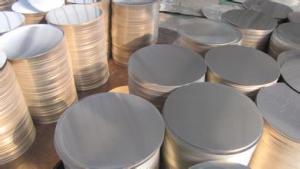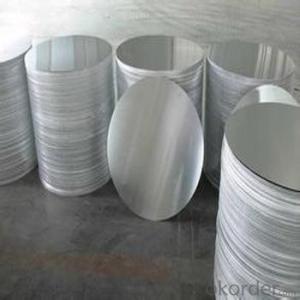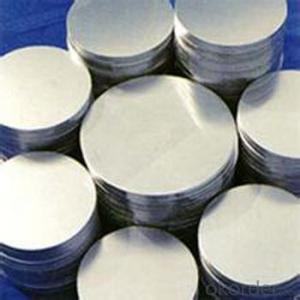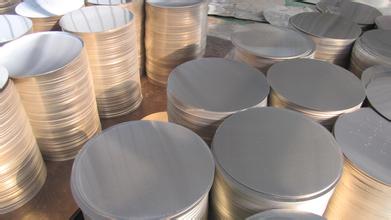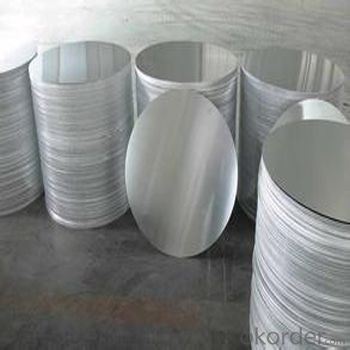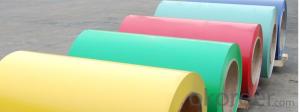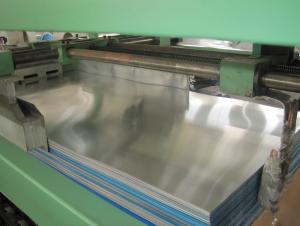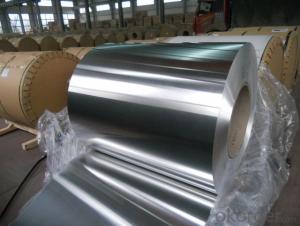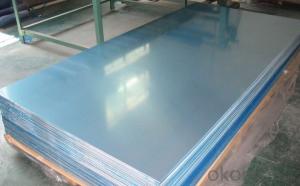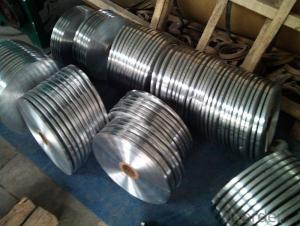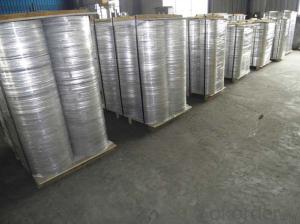Nordc Ware Aluminum Baking Sheets - Circles, Plates, and Pans
- Loading Port:
- Tianjin
- Payment Terms:
- TT OR LC
- Min Order Qty:
- 10 m.t.
- Supply Capability:
- 300 m.t./month
OKorder Service Pledge
OKorder Financial Service
You Might Also Like
Specification
1.Description
Aluminium foil (or aluminum foil) is aluminium prepared in thin metal leaves with a thickness less than 0.2 millimetres (8 mils); thinner gauges down to 6 micrometres (0.24 mils) are also commonly used.In the United States, foils are commonly gauged in thousandths of an inch or mils. Standard household foil is typically 0.016 mm (0.63 mils) thick, and heavy duty household foil is typically 0.024 mm (0.94 mils). Thefoil is pliable, and can be readily bent or wrapped around objects. Thin foils are fragile and are sometimeslaminated to other materials such as plastics or paper to make them more useful. Aluminium foil supplantedtin foil in the mid 20th century.
2.Specification
ALLOY:AA1***(AA1050,AA1070,AA1100etc)
AA3***(AA3003 etc)
TEMPER:O,H14
THICKNESS:0.5mm-4mm
DIAGONAL:100mm-1200mm
STANDARD:GB/T 3880-2006
Special specification is available on customer's requirement
3.Other requirement
SURFACE QUALITY: GOOD APPEARANCE WITH NO-CRACK AND WELL-DISTRIBUTE GRAIN.
BUILD UP: TIGHT SLIT EDGES FREE FROM CRACKS, LAYER TO LAYER SHIFT NOT MORE THAN 2MM.
PROFILE: -0/+1%
FLATNESS: MILL FLATNESS COIL HAVING EDGE WAVINESS RATHER THAN CENTER BUCKLES SHALL BE ACCEPTABLE.
ROLLING PERFORMANCE: RE-ROLLABLE TO THE FINAL DESIRES GAUGES
4.Picture
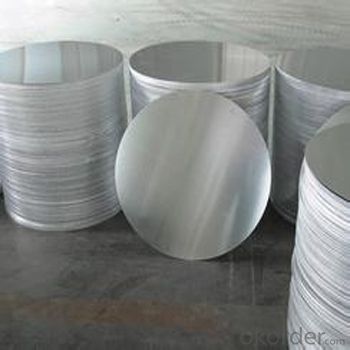
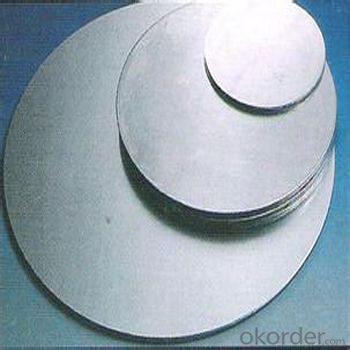
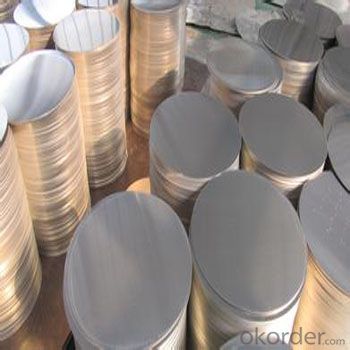
5.FAQ
①How about your company?
A world class manufacturer & supplier of castings forging in carbon steel and alloy steel,is one of the large-scale professional investment casting production bases in China,consisting of both casting foundry forging and machining factory. Annually more than 8000 tons Precision casting and forging parts are exported to markets in Europe
,America and Japan. OEM casting and forging service available according to customer’s requirements.
②How to guarantee the quality of the products?
We have established the international advanced quality management system,every link from raw material to final product we have strict quality test;We resolutely put an end to unqualified products flowing into the market. At the same time, we will provide necessary follow-up service assurance.
- Q: How do I choose the right thickness for my aluminum sheet?
- Choosing the right thickness for your aluminum sheet depends on several factors such as the intended application, required strength, and desired weight. Thicker sheets offer increased strength and durability, making them suitable for heavy-duty applications, while thinner sheets are lighter and more flexible, ideal for applications that require flexibility or weight reduction. It is essential to consider the specific requirements of your project and consult with experts or reference material to determine the appropriate thickness that meets your needs.
- Q: Are aluminum sheets lightweight?
- Yes, aluminum sheets are lightweight. Aluminum is known for its low density, making it a popular choice for applications where weight is a concern. Compared to other metals like steel, aluminum is significantly lighter, which makes it easier to handle and transport. Despite its lightweight nature, aluminum sheets are still strong and durable, making them suitable for a wide range of uses such as in the aerospace industry, automotive manufacturing, construction, and packaging.
- Q: Can aluminum sheets be easily shaped or bent?
- Indeed, aluminum sheets possess a remarkable capability to be effortlessly molded or flexed. Renowned for its exceptional malleability and ductility, aluminum exhibits a remarkable propensity to be readily fashioned into diverse contours and curves. The manipulation of this versatile metal can be accomplished through an assortment of techniques, encompassing rolling, pressing, and even manual utilization of tools. Given its pliability, aluminum emerges as the preferred choice within industries such as automotive, aerospace, and construction, wherein the fabrication of intricate shapes and bends is a common necessity. Moreover, the lightweight nature and inherent resistance to corrosion further enhance aluminum's suitability for shaping and bending endeavors.
- Q: What is the composition of 101 aluminum sheets?
- The composition of 101 aluminum sheets typically consists of 99.5% pure aluminum with trace amounts of other elements such as iron and silicon.
- Q: What are the different methods of surface preparation for aluminum sheet?
- There are several methods of surface preparation for aluminum sheet, depending on the desired finish and application. 1. Chemical Cleaning: This method involves using chemical solutions to remove any dirt, grease, or surface contaminants from the aluminum sheet. The sheet is typically soaked in the cleaning solution and then rinsed thoroughly to ensure all residues are removed. 2. Mechanical Cleaning: This method utilizes mechanical processes such as sanding, grinding, or brushing to remove any surface imperfections or coatings. Sanding or grinding can be done using abrasive materials or tools, while brushing involves using wire brushes to scrub the surface. 3. Etching: Etching is a process that uses chemicals to create a roughened surface on the aluminum sheet. This can be done by applying an acid or alkaline solution to the surface, which removes a thin layer of the metal and creates a textured finish that improves adhesion for subsequent coatings or finishes. 4. Anodizing: Anodizing is a specialized surface preparation method that involves creating an oxide layer on the aluminum sheet. This is achieved by immersing the sheet in an electrolytic solution and passing an electric current through it. Anodizing not only enhances the appearance of the aluminum sheet but also provides a protective layer against corrosion. 5. Conversion Coating: Conversion coating is a chemical process that converts the surface of the aluminum sheet into a more corrosion-resistant material. This can be achieved through methods like chromate conversion coating or phosphate conversion coating. These coatings provide an added layer of protection and can also improve the bonding of subsequent coatings. Each method of surface preparation for aluminum sheet has its own advantages and is chosen based on the specific requirements of the application. It is important to select the appropriate method to ensure proper adhesion of coatings and finishes, as well as to enhance the overall durability and appearance of the aluminum sheet.
- Q: Does aluminum resist fire or is it not susceptible to catching fire?
- <p>Aluminum sheets are not fireproof but have a high resistance to fire. They do not burn or support combustion like wood or paper. Aluminum has a melting point of around 660掳C (1220掳F), and it forms a protective oxide layer when heated, which prevents further oxidation and slows down the heating process. While it can get hot and deform under extreme heat, it won't catch fire or contribute to a fire's spread. However, it's important to note that aluminum can still conduct heat, so it's not completely immune to the effects of fire.</p>
- Q: What are the different packaging options available for aluminum sheets during transportation?
- There are several packaging options available for aluminum sheets during transportation to ensure their safety and prevent any damage. Some of the commonly used packaging options include: 1. Wooden Crates: Aluminum sheets can be packed in wooden crates, which provide excellent protection against impacts and rough handling. These crates are usually made of strong and durable wood and can be customized according to the size and weight of the sheets. 2. Cardboard Boxes: For smaller quantities or smaller-sized aluminum sheets, cardboard boxes are a popular packaging option. The sheets are carefully stacked and securely packed inside the boxes, which are then sealed to prevent any movement or damage during transportation. 3. Pallets: Aluminum sheets can also be packed on pallets, which are wooden or plastic platforms used for easy handling and transportation. The sheets are stacked and strapped onto the pallets to ensure stability and protection during shipping. 4. Stretch Wrap: Another option is to use stretch wrap to secure the aluminum sheets together. The sheets are tightly wrapped using a plastic film, which helps to keep them in place and protect them from scratches and other minor damages. 5. Protective Film: A common practice is to apply a protective film on the surface of aluminum sheets before packaging. This film acts as a barrier against moisture, dust, and scratches, providing an extra layer of protection during transportation. 6. Edge Protectors: To prevent any damage to the edges of the aluminum sheets, edge protectors can be used. These are typically made of plastic or cardboard and are placed on the edges to absorb any impacts and ensure the sheets remain intact. 7. Customized Packaging: Depending on the specific requirements of the aluminum sheets and the transportation method used, customized packaging solutions can be designed. This may include using foam inserts, dividers, or additional cushioning materials to provide maximum protection during transit. It is important to choose the appropriate packaging option based on the size, weight, and fragility of the aluminum sheets, as well as the mode of transportation and the distance they need to travel. Proper packaging plays a crucial role in preventing any damage and ensuring the sheets reach their destination in optimal condition.
- Q: Can aluminum sheets be used in the aerospace industry?
- Yes, aluminum sheets can be used in the aerospace industry. Aluminum is a lightweight material with excellent strength-to-weight ratio, making it a popular choice for various aerospace applications. It is commonly used in the construction of aircraft structures, such as fuselages, wings, and panels. The use of aluminum sheets in the aerospace industry offers several benefits, including reduced fuel consumption due to the weight savings, improved maneuverability, and increased payload capacity. Additionally, aluminum exhibits good corrosion resistance, which is crucial for aircraft exposed to harsh environmental conditions. Overall, aluminum sheets are widely utilized in the aerospace industry for their favorable properties and performance.
- Q: I found a baby dish at a yard sale and all it says on the bottom is Lydney Aluminum PRODUCTS FOR BETTER LIVING. It appears old. Thanks. I already checked google.
- lydney appears to be a place in england. they probably get their aluminium there.
- Q: does aluminum sheet need to conduct ROHS detection?it's metel material, how much detections should it conduct for ROHS detection?
- generally, all things in Europe needs ROSH EU's requirement, mainly detect the plumbum. ROSH detection is conducted by third party institution, and its report is also provided by the third party.
Send your message to us
Nordc Ware Aluminum Baking Sheets - Circles, Plates, and Pans
- Loading Port:
- Tianjin
- Payment Terms:
- TT OR LC
- Min Order Qty:
- 10 m.t.
- Supply Capability:
- 300 m.t./month
OKorder Service Pledge
OKorder Financial Service
Similar products
Hot products
Hot Searches
Related keywords
